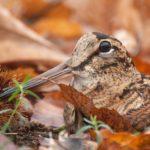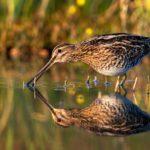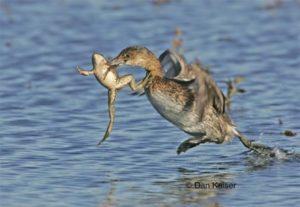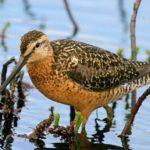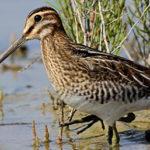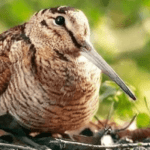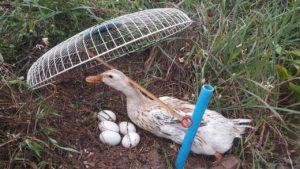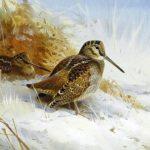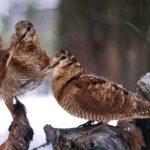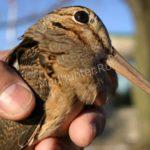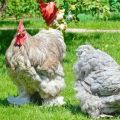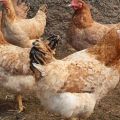What kind of woodcock bird is and what it looks like, habitats and what they eat
You can meet a woodcock only in a remote area of the forest, so most people know about a bird of the snipe family from the hunting stories of literary classics. In Russia, the bird is called the upland or forest sandpiper. Picturesque plumage, tasty meat make the woodcock a favorite hunting object. Only a seasoned hunter can get a careful dexterous bird that can dissolve among the forest, merge with the environment.
Origin of appearance and appearance
The bird belongs to the snipe family, which is part of the charadriiformes. The name has German roots - "Waldschnepfe" ("forest snipe"). In terms of external parameters of the body, the bird is similar to the dove. A characteristic difference is a long narrow beak and variegated plumage in shades of brown, red-brown.
Appearance features:
- dense, squat body with a short neck;
- feathered thighs;
- weight - 200-450 grams;
- length - 32-38 centimeters, wingspan - 55-65 centimeters;
- an even, straight beak in the form of a cylinder reaches 7-9 centimeters.
The plumage is a patronizing species, reliably hides the bird from prying eyes. The brownish-brown color of the feather is complemented by spots of gray, black, red on the upper part of the body. Due to this, the woodcock is not noticeable against the background of last year's foliage and grass, it is camouflaged from the eyes of predators and hunters. The belly is lighter in color in shades of yellow and gray with black splashes. The chick at an early age has a yellowish plumage with brown and black spots.
The wings are wide; in flight, the woodcock resembles an owl. The eyes are located in the center of the head, which provides an all-round view of the wood snake. Females and males do not differ externally. The coloration is slightly differentiated only in young and adult individuals.

Note: on each wing of a woodcock there is one characteristic feather, narrow and dense. Feathers are suitable for drawing especially thin lines, therefore they are in demand by artists.
Habitat
The forest-steppe and forest zones of Eurasia are the habitats of the forest sandpiper. The range covers the entire continent from the Pyrenees to the Pacific coast. Outside this zone, woodcocks also settle in Japan, the Canary Islands, the Azores, and Britain. In Russia, the habitat zone begins in the north of the Solovetsky Islands, captures the Black Earth Region, the Volga Region, Western Siberia, Altai, Primorye.
Most woodcocks are migratory birds. Only the inhabitants of the Atlantic islands and warm coastal countries do not leave their places. Woodcocks migrate singly or in small groups. Usually they return to their original place.The flight period of woodcocks starts with the approach of frost - at the end of September-November, depending on the habitat. Birds migrate to the following regions:
- Iran;
- Afghanistan;
- North Africa;
- south, west of Europe;
- Indochina.
The woodcock lives in secluded places of forests - mixed or deciduous type. Forest sandpipers settle near water bodies, small marshes, in secluded places with undergrowth of raspberry and hazel bushes. The woodcock takes a fancy to areas of the forest that look inaccessible due to dense deadwood, low-growing ferns.
What does the bird eat?
The solid long beak allows woodcocks to get their favorite food - earthworms. Therefore, for living, the bird chooses the shores of reservoirs, where the moist, loose soil is densely populated with worms, insect larvae. The forest sandpiper's diet includes:
- insects and larvae - sawflies, beetles, earwigs, spiders;
- vegetable food - berries, grains, grass shoots, seeds;
- small molluscs and crustaceans - more often during migration.
There are nerve endings on the woodcock's beak that catch the movement of living creatures in the ground. The bird plunges its beak into the soil up to its nostrils and looks for prey. In the absence of worms, it eats small insects, young greenery.
The woodcock starts looking for food at night. The bird turns over pieces of bark, foliage with its beak, looking for larvae and insects. To search for worms, the forest sandpiper digs in soft humus, cow droppings. Plant roots also serve as food.

By the time of the flight, the forest sandpiper stores fat for future use. With the beginning of autumn, the woodcock leaves the forest and feeds on the grain fields, getting roots and seeds. Day hides in the forest, and at night looking for food. Unlike ducks, the forest sandpiper rarely feeds on small aquatic fauna, only during migration.
Features of the character and lifestyle of a woodcock
The forest sandpiper is a loner, leads a hermitic lifestyle. Males and females meet only at the time of mating, then part. Even woodcocks often fly one by one, not gathering in a flock. In mountainous regions (Caucasus), the bird often migrates vertically - in the summer it rises high, during a cold snap it sinks down to the sea.
The bird's lifestyle is nocturnal. The day is given to rest, the woodcock climbs into the thick of the forest, it is difficult to find it among the fresh and old foliage. The plumage of a complex natural color and innate caution make woodcocks invisible against any background. The bird hides from predators and hunters, goes out for food only at night. When danger appears, it flies up vertically, confusing the enemy. Woodcocks are excellent flyers, sharp, dexterous, and perform intricate complex movements in flight.
Wood sandpipers practically do not produce sounds, do not sing, so it is difficult to find their habitats. The only exception is the mating season, during which males and females call each other with characteristic sounds.
Social structure and reproduction
Woodcocks do not form married couples even for one season. The male is looking for a partner, flying at night over the places of possible habitation of females, and makes grunting sounds ending with a high whistle. If the female responds, the pair stays together for several days. Then the male flies away and looks for a new girlfriend, fertilizing 3-4 females during the season.
The female makes a nest in advance in the most secluded parts of the forest on the ground. The bottom of the hole is lined with moss, grass, foliage. Departure from the nest is usually free, the bird can suddenly soar into the air in case of danger. Clutch - 3-4 eggs, incubation time - 21-23 days. The female is engaged in incubating and raising offspring alone. The eggs are beige-yellow with brown spots.During the day, the mother leaves 3-4 times to feed near the nest.
After 7-13 days, the chicks already leave the nest and feed on their own, studying the nearby surroundings. In case of danger, the female leads people or predators away from the dwelling, diverting attention to herself. At 3 weeks, woodcock chicks get up on the wing, at the age of a little over a month they become independent. At first they stick together, then they settle in one area.

Natural enemies
The camouflage coloring of the woodcock serves as protection from enemies, of which the bird has a lot. Daytime feathered predators are not particularly dangerous, since it is almost impossible to find a forest sandpiper hiding in dense thickets. Night birds are dangerous for woodcocks, they go hunting when the woodcock is feeding. Owls and eagle owls are agile enough to catch a woodcock in flight.
The most vulnerable are females sitting on the clutch and feeding offspring. Females and chicks often become prey for foxes, martens, weasels, badgers, ferrets. Nests are also ravaged by hedgehogs and small rodents carrying eggs and newborn chicks.
A significant part of the population perishes during the spring and autumn flights due to the difficulties of the path and the hunters who watch them on the way. Hunting for woodcocks has long passed from a method of obtaining food into a sports competition, but there are more and more people who want to shoot a cautious bird.
Note: most woodcocks do not live out their days (10-11 years), die in the claws of predators or at the hands of hunters.
Population and status of the species
Despite the impressive number of enemies, including humans, international environmental organizations believe that the existence of the woodcock population is not threatened. The bird's habitat remains the same, capturing vast areas of Eurasia.
Hunting for forest waders in each country is regulated, trying to protect birds from destruction and decline in numbers. Sports hunting is not losing its popularity, woodcocks are a welcome prey. Stuffed birds, because of their beautiful plumage, are in great demand; woodcock dishes adorn the menus of expensive restaurants.
The main danger to the population is not from wild and civilized hunters, but from changing living conditions. Secluded places where cautious flyers can easily exist are becoming less and less. Regulation of hunting seasons and protection of nature from aggressive human influences are the main directions for preserving the number of woodcocks.

Bird hunting
The Russian nobility was also fond of hunting woodcocks. The main hunting trophies are valuable meat and skins, from which stuffed animals are made, popular because of their beautiful, colorful plumage. Hunting for forest waders is divided into 3 seasons - spring, before hatching, summer and autumn, before migration. Shooting of females is limited so as not to reduce the population. It is allowed to shoot males. To attract cautious birds, a decoy is used, which makes sounds characteristic of females. The males fly on them on a pull.
It is convenient to hunt woodcocks with a dog, which will find shot prey and bring it to the owner. Otherwise, it is impossible to find a dead sandpiper among the grass and bushes. Another task of the cops is to find the habitat of the bird, frighten it off, and lift it onto the wing. At this time, the owner can shoot.
When hunting on traction, the main difficulty is to find places for the mass flight of males, skillfully use decoys. The forest sandpipers caught during the autumn hunt are the most delicious - they have worked up fat before the long flight. Woodcock hunting is difficult, requires patience and accuracy, is dynamic and very reckless.
Woodcock Meat Dishes
Sandpiper meat does not have a characteristic game smell, so it does not need to be soaked. Experienced chefs recommend cooking woodcock with lard to make the dish tender and juicy.When frying, it is better to use butter (ghee) instead of vegetable oil; for juiciness, add meat broth (chicken, beef).
In red wine
One carcass will require:
- pork fat - 50 grams;
- dry red wine - 100 milliliters;
- a handful of juniper berries;
- spice.
Prepare the carcass - wash, gently move the skin. Grate the meat with berries, put thin pieces of bacon on top. Return the skin to its place. Place the game in a deep saucepan, pour over the wine. After boiling, cook for 30-40 minutes (until soft).
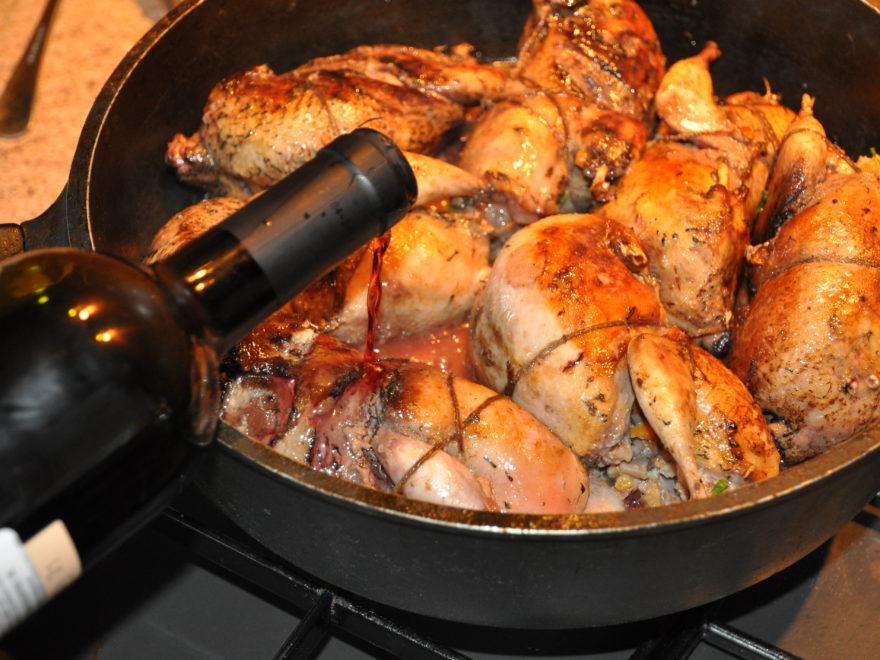
Stuffed
To prepare a dish of 6 birds you will need:
- white bread - 200 grams;
- milk - 100 milliliters;
- grated cheese - 150 grams;
- egg;
- greenery;
- butter - 150 grams.
Minced meat is prepared. The bread is soaked in milk, chopped with a fork. Stir in chopped greens, egg, cheese, 50 grams of butter. Carcasses are filled with minced meat, tied with a thread. Spread in a skillet with melted butter and fry until crisp. Add broth and bring to readiness in the oven.
It is difficult to see a woodcock, the bird is a true master of disguise. Most people are familiar with the bird from photographs and TV shows. At the same time, nature lovers are pleased to know that large populations of a cautious and beautiful bird, famous in fiction and painting, live in the forests.
